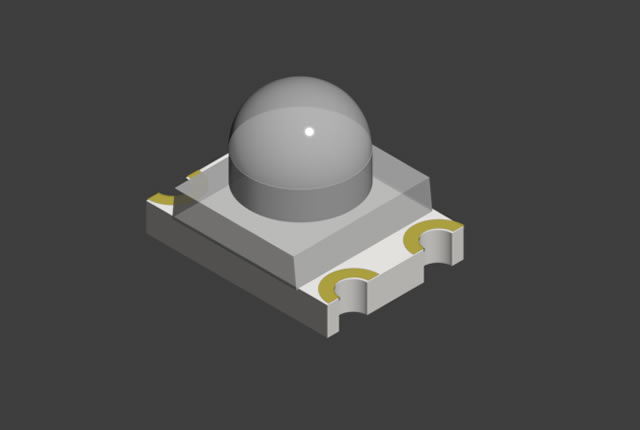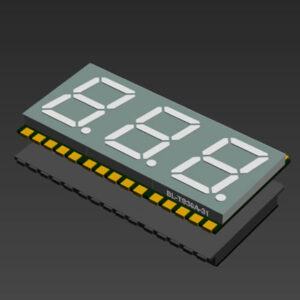1206 SMD LED | DOME | bi-color | Green
Article No:
Color:
Weight:(g/pcs)
Dimension:(mm)
Inquiry
Related Article List
Article No | color | material | wavelength | apperance | v_typ | v_max | luminous_min | luminous_typ | degree |
|---|---|---|---|---|---|---|---|---|---|
Red |
GaAsP |
635 |
Water Clear |
2.6 |
10 |
20 |
60 |
||
Ultra Red |
AlInGaP |
630 |
Water Clear |
2.6 |
250 |
500 |
60 |
||
Ultra Yellow |
AlInGaP |
593 |
Water Clear |
2.6 |
250 |
500 |
60 |
Product Series information
Product Series |
|---|
 Series No:BL-LS3224A1E2 Dimension 3.2 × 2.4 × 2.4 mm Description: ___________________________________________________________________________________________________________________________________________________ Advancing Light Technology: The Power of 3224 LED with Bi-Color CapabilityIn the realm of modern electronics, the implementation of efficient lighting solutions is critical. Among these solutions, the 3224 LED has become a benchmark for performance and versatility, particularly when it is enhanced with bi-color functionality. This technology, embedded within the 1206 SMD LED DOME configuration, offers an array of benefits for electronic devices, spanning from consumer electronics to specialized industrial equipment. This article explores the features, applications, and substantial advantages of these innovative LEDs, bolstered by case studies and testimonials from users across various industries.Features of 1206 SMD LED, DOME, Bi-ColorThe 1206 SMD LED DOME, equipped with bi-color capabilities, stands out due to its compact design and dual light output, which can emit two distinct colors from a single package. This feature is particularly beneficial in applications requiring color-coded signals or status indications. The DOME design not only enhances the luminous intensity but also provides a focused beam of light, making it ideal for high precision tasks that require clear visibility.Diverse Applications of Bi-Color 3224 LEDsThe versatility of the 3224 LED with bi-color functionality extends across various fields:
Unmatched Benefits of Using 3224 LEDsAdopting 3224 LEDs in electronic designs translates into several tangible benefits:
Case Studies: Real-World Impact of 3224 Bi-Color LEDsNumerous enterprises have witnessed substantial improvements by integrating 3224 LEDs into their systems. A notable example includes a tech manufacturer that redesigned its assembly line indicators with these LEDs, resulting in a 30% drop in operator errors due to the clearer status indications.User Testimonials: Voices from the FieldFeedback from users consistently highlights the effectiveness of the 3224 LED in enhancing device functionality. One electronics engineer noted, "The bi-color feature of the 3224 LEDs has allowed us to streamline our product design, reducing component count while increasing usability."Exploring UV-C Lights in Conjunction with 3224 LEDsThe application of UV-C lights in conjunction with 3224 LEDs is gaining traction, especially in sterilization and disinfection solutions. These LEDs can be used to create devices that not only function efficiently in everyday use but also ensure environmental cleanliness, crucial in healthcare settings.Conclusion: Embracing the Future with 3224 LEDsThe 3224 LED with bi-color functionality is a prime example of how innovative lighting technology can adapt to meet the evolving needs of modern electronics. For manufacturers, engineers, and designers, these LEDs offer a pathway to enhance product features, operational efficiency, and user satisfaction. We invite you to explore the potential of 3224 LEDs in your next project—transform your products with cutting-edge light technology today.
___________________________________________________________________________________________________________________________________________________ Dimension and Circuit Drawing:  |
Related Information
Soldering
When soldering, leave a minimum of 2mm clearance from the base of the base of the lens to the soldering point. Dipping the lens into the solder must be avoided.
Do not apply any external stress to the lead frame during soldering while the LED is at high temperature.
Recommended soldering conditions:
| IR Reflow Soldering (for SMD display) | Wave Soldering | Soldering Iron | |||
| Pre-Heat | 150-180°C | Pre-Heat | 100°C Max. | Temperature | 300°C Max. |
| Pre-Heat Time | 120sec Max. | Pre-Heat Time | 60sec Max. | ||
| Peak Temperature | 260°C Max. | SolderWave | 260°C Max. | Soldering Time | 3sec Max.(one time only) |
| Soldering Time | 10 sec Max. | Soldering Time | 5sec Max. | ||
Note: Excessive soldering temperature and/or time might result in deformation of the LED lens or failure of the LED
ESD(Electrostatic Discharge)
Static Electricity or power surge will damage the LED.
Suggestions to prevent ESD (Electrostatic Discharge):
n Use a conductive wrist band or anti-electrostatic glove when handling these LEDs
n All devices, equipment, and machinery must be properly grounded
n Work tables, storage racks, etc. should be properly grounded
n Use ion blower to neutralize the static charge which might have built up on surface of the LED’s
plastic lens as a result of friction between LEDs during storage and handling
ESD-damaged LEDs will exhibit abnormal characteristics such as high reverse leakage current,
low forward voltage, or “no light on” at low currents. To verify for ESD damage, check for “light on”
and Vf of the suspect LEDs at low currents.
The Vf of “good” LEDs should be>2.0V@0.1mA for InGaN product and >1.4V@0.1mA for AlInGaP
product.

When selecting power for LED systems, it’s essential to understand several key parameters to ensure safe operation, longevity, and optimal performance. Here are some steps and considerations for LED power selection:
- Determine the Forward Voltage (Vf) of the LED(s):
Each LED has a forward voltage, which is the voltage at which the LED operates when the current is flowing through it. This value can typically be found in the LED’s datasheet.
- Determine the Forward Current (If) of the LED(s):
The forward current is the current at which the LED is designed to operate. Running an LED at higher than its rated current can reduce its lifespan and increase the heat it produces.
- Decide on the Configuration:
Series Configuration: When LEDs are connected in series, the forward voltages add up, but the current remains the same.
Parallel Configuration: When LEDs are connected in parallel, the forward voltage remains the same, but the currents add up. This configuration can be risky because if one LED fails or has a slightly lower forward voltage, it can cause the other LEDs to draw more current.
Calculate Total Power Requirements:
Power (W) = Total Forward Voltage (V) x Total Forward Current (A)
For example, if you have three LEDs connected in series, each with a forward voltage of 3V and a forward current of 20mA, the total power requirement would be:
Power = (3V + 3V + 3V) x 20mA = 9V x 0.02A = 0.18W
- Select an Appropriate Power Supply:
- Voltage Rating: The power supply voltage should match or slightly exceed the total forward voltage of your LED configuration.
- Current Rating: The power supply’s current rating should meet or exceed the total forward current of your LED configuration.
- Safety Margin: It’s a good practice to select a power supply that can provide at least 20% more power than your calculated requirement. This ensures the power supply isn’t operating at its maximum capacity, which can extend its life and ensure safer operation.
- Consider Additional Features:
- Dimming Capability: If you want to control the brightness of your LEDs, choose a power supply with dimming capabilities.
- Overcurrent and Overvoltage Protection: To protect your LEDs, select a power supply with built-in protection mechanisms.
- Thermal Management: Ensure that the power supply has adequate cooling, especially if it will be enclosed or in a location with limited airflow.
- Regulation and Efficiency:A power supply with good regulation will maintain a consistent voltage output despite variations in the load. High efficiency ensures minimal power is wasted as heat.
- Physical Size and Form Factor:Depending on where you plan to place the power supply, its size and shape may be critical factors.
In summary, when selecting power for LED systems, understanding your LED’s requirements and the configuration you plan to use is essential. Then, pick a power supply that meets those needs with some added safety margin, keeping in mind any additional features or constraints relevant to your project.
Here are some well-regarded brands in the industry:
- Mean Well: One of the most recognized brands in the LED power supply industry, Mean Well offers a wide range of products suitable for both indoor and outdoor applications. Their units often come with features like overcurrent protection, dimming capabilities, and high efficiency.
- Tridonic: A global leader in lighting technology, Tridonic offers LED drivers and power supplies that cater to various lighting solutions, from simple setups to advanced smart lighting systems.
- Philips Advance Xitanium: Philips is a well-known brand in the lighting industry, and their Xitanium series of LED drivers are known for reliability and performance. They cater to both indoor and outdoor LED applications.
- Osram: Another giant in the lighting industry, Osram offers a range of LED drivers and power supplies suitable for various applications, including architectural and street lighting.
- LIFUD: Specializing in LED drivers, LIFUD is known for its high-quality products that cater to both commercial and residential LED lighting solutions.
- MOSO: This brand offers a variety of LED drivers, especially for outdoor and industrial applications. Their products are known for durability and performance.
- TDK-Lambda: With a history in power electronics, TDK-Lambda offers a range of power supplies and LED drivers suitable for various applications, emphasizing reliability and advanced features.
Need help?
Related products
-

wyświetlacz bargarph (prostokątny, 20-segmentowy
Quick View View products -

Dioda LED IR, miniaturowe urządzenie LED, okrągła wieża 1,8 m
Quick View View products -

SMD wyświetlacz siedmiosegmentowy 0,39 cala 3 cyfr
Quick View View products -

SMD wyświetlacz siedmiosegmentowy 0,3 cala 4 cyfr
Quick View View products